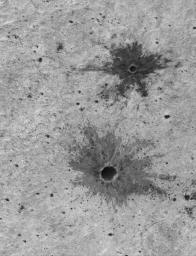
|
Small Impact Craters with Dark Ejecta Deposits
- Click the image above for a larger view
- Full-Res JPEG (720 x 944) (150.9 kB)
- Full-Res TIFF (720 x 944) (674.7 kB)
Caption:
When a meteor impacts a planetary surface, it creates a blast very much like a bomb explosion. Shown here are two excellent examples of small impact craters on the martian surface. Each has a dark-toned deposit of material that was blown out of the crater (that is, ejected) during the impact. Materials comprising these deposits are called ejecta. The ejecta here is darker than the surrounding substrate because each crater-forming blast broke through the upper, brighter surface material and penetrated to a layer of darker material beneath. This darker material was then blown out onto the surface in the radial pattern seen here.
The fact that impact craters can penetrate and expose material from beneath the upper surface of a planet is very useful for geologists trying to determine the nature and composition of the martian subsurface. The scene shown here is illuminated from the upper left and covers an area 1.1 km (0.7 mi) wide by 1.4 km (0.9 mi). The larger crater has a diameter of about 89 meters (97 yards), the smaller crater is about 36 meters (39 yards) across. The picture is located in Terra Meridiani and was taken by the Mars Global Surveyor Mars Orbiter Camera.
Background Info:
Malin Space Science Systems and the California Institute of Technology built the MOC using spare hardware from the Mars Observer mission. MSSS operates the camera from its facilities in San Diego, CA. The Jet Propulsion Laboratory's Mars Surveyor Operations Project operates the Mars Global Surveyor spacecraft with its industrial partner, Lockheed Martin Astronautics, from facilities in Pasadena, CA and Denver, CO.
Cataloging Keywords:
| Name | Value | Additional Values |
|---|---|---|
| Target | Mars | |
| System | ||
| Target Type | Planet | |
| Mission | Mars Global Surveyor (MGS) | |
| Instrument Host | Mars Global Surveyor | |
| Host Type | Orbiter | |
| Instrument | Mars Orbiter Camera (MOC) | |
| Detector | ||
| Extra Keywords | Crater, Dust, Grayscale, Impact | |
| Acquisition Date | ||
| Release Date | 2000-09-18 | |
| Date in Caption | ||
| Image Credit | NASA/JPL/MSSS | |
| Source | photojournal.jpl.nasa.gov/catalog/PIA01683 | |
| Identifier | PIA01683 | |
